Anthurium Care: The Flamingo Flower Growing Guide
These Anthurium care and growing tips will help you out. This may not be the easiest houseplant, but it’s well worth it.
I first saw a picture of an Anthurium in a magazine in my teens (many moons ago, way before the internet took over our lives) and had never seen anything like it before. A few years later, when living in New York City, I walked into a bank with a huge flower arrangement full of them. I touched one of the waxy blooms and was in floral heaven.
The plants are sold in the houseplant trade but can be tricky to grow indoors. They’re tropical plants that grow outdoors in places with high humidity and mild winters, like Hawaii, Florida, and the tropical rainforests of South America and the Caribbean.
There are many species and varieties of them, and these anthurium care tips apply to them all. The one I’ve seen commonly sold as a houseplant is the Anthurium andraeanum. That’s the one I have.
Botanic Name: Anthurium spp. Common Names: Anthurium, Flamingo Flower, Little Boy Plant, Red Peace Lily, Red Heart Plant.
Anthurium Plant Traits
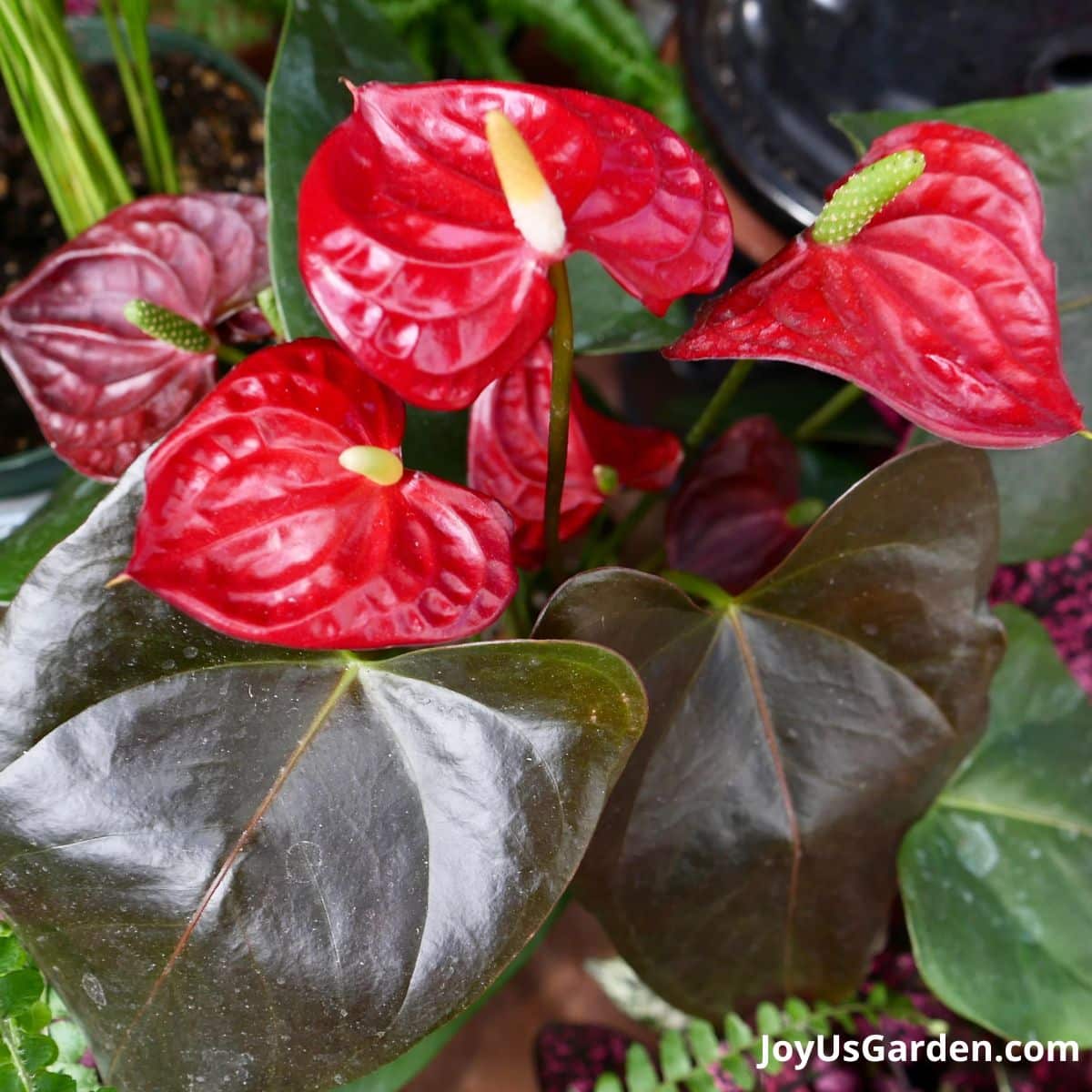
Size
They’re typically found in 4″ and 6″ pot sizes. The height ranges from 10″ to 20″.
Growth Rate
Anthuriums are slow to moderate growers. If the conditions are to their liking, they’ll grow faster. When light levels are too low, the growth rate will be slow to none. It’s almost summer as I’m writing this, and mine is putting out a lot of new growth at the base.
Uses
The most common use for anthuriums is as a blooming tabletop plant. The smaller ones (4″ pot size) are often used in dish gardens.
Anthurium Colors
The red anthurium plant is the most common. Other colors include white, pink, maroon, green, purple, and bi-color (pink/green and red/green).
Close Relatives
I’m adding these in for fun because I also have them growing in my home. In the same plant family as the Anthurium are the popular houseplants: Pothos, Monstera deliciosa, Arrowhead Plant, and Peace Lily.
Anthurium Care and Growing Tips
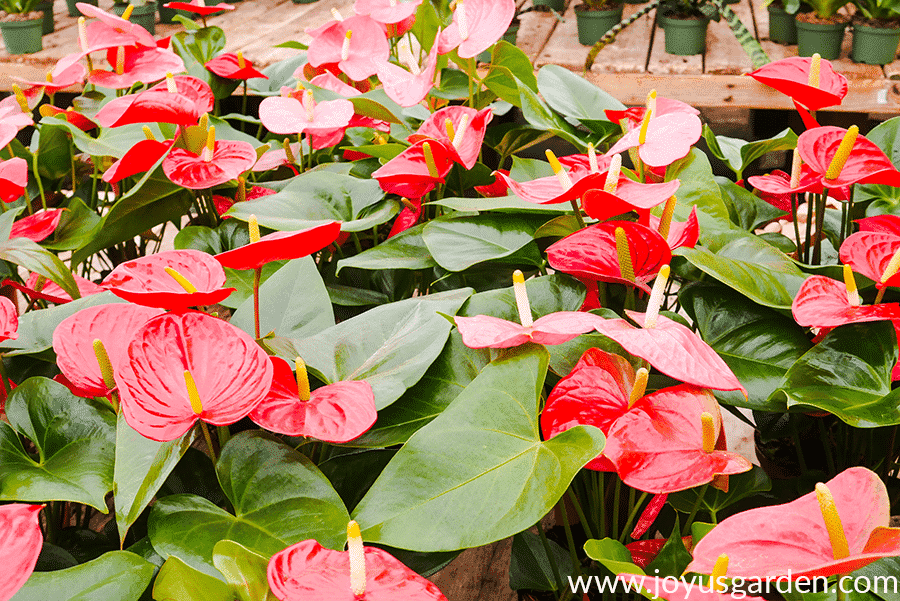
If you’re growing your Anthurium plants as temporary color (the flowers last about six weeks), like some people do orchids and bromeliads, you can skip most of this except for light requirements and watering. They won’t be tricky to keep alive for a couple of months.
I prefer to keep them as long-lasting houseplants because I love the foliage as much as the flowers. Here’s what I’ve learned about growing anthuriums over the past 20 years.
Anthurium Light Requirements
Anthuriums prefer moderate or medium light and need this exposure to bloom. Near but not on a sunny windowsill is good. In lower light levels, your plant will show little (if any) growth, and there won’t be any flowering.
If in too much light (direct sunlight like a hot, south, or west exposure close to a window), your plant will burn. Anthuriums are epiphytic, just like orchids and bromeliads. In their natural environments, they grow under the cover of other plants.
Mine lives on a tea cart in my dining room 4′ away from a trio of east-facing windows. It gets plenty of bright indirect light and has repeat-bloomed several times. Because of the low humidity here in the desert, the blooms have gotten smaller.
If growing next to a wall or in a corner, rotate it every couple of months so it receives light evenly on all sides. You may have to move it to a brighter spot in the darker, colder months.
There are things to know about caring for indoor plants in winter. This guide to Winter Houseplant Care will help you out.
Watering
Watering is a big part of anthurium care. Mine gets watered once a week at the moment. I take it to my kitchen sink for watering and spray the foliage. Just like a brief tropical rain!
The weather is heating up here in Tucson, so I’ll start to water mine every five days through August. I water it every ten to fourteen days in winter, depending on the temps and light levels.
Your anthurium might need more or less depending on the conditions of your home. The more light and warmth, the more often yours will need watering. I let mine go almost dry before watering again.
One thing: back off on the frequency in the winter. Plants rest a bit at this time of year, plus the light levels and temps tend to be lower.
Even though this plant doesn’t like to dry out for a prolonged period, it doesn’t like to stay sopping wet or sit in a saucer of water. So be sure the water drains through before putting it back on the saucer or in the decorative pot.
Because they’re epiphytes, don’t keep your Anthurium constantly wet. They’re subject to root rot. I let mine almost dry out before watering it again.
Another thing to watch out for is moisture on the leaves. Mine dry out fast here, but fungus on the foliage can be an issue.
This guide to Watering Indoor Plants will shed more light on houseplant watering.
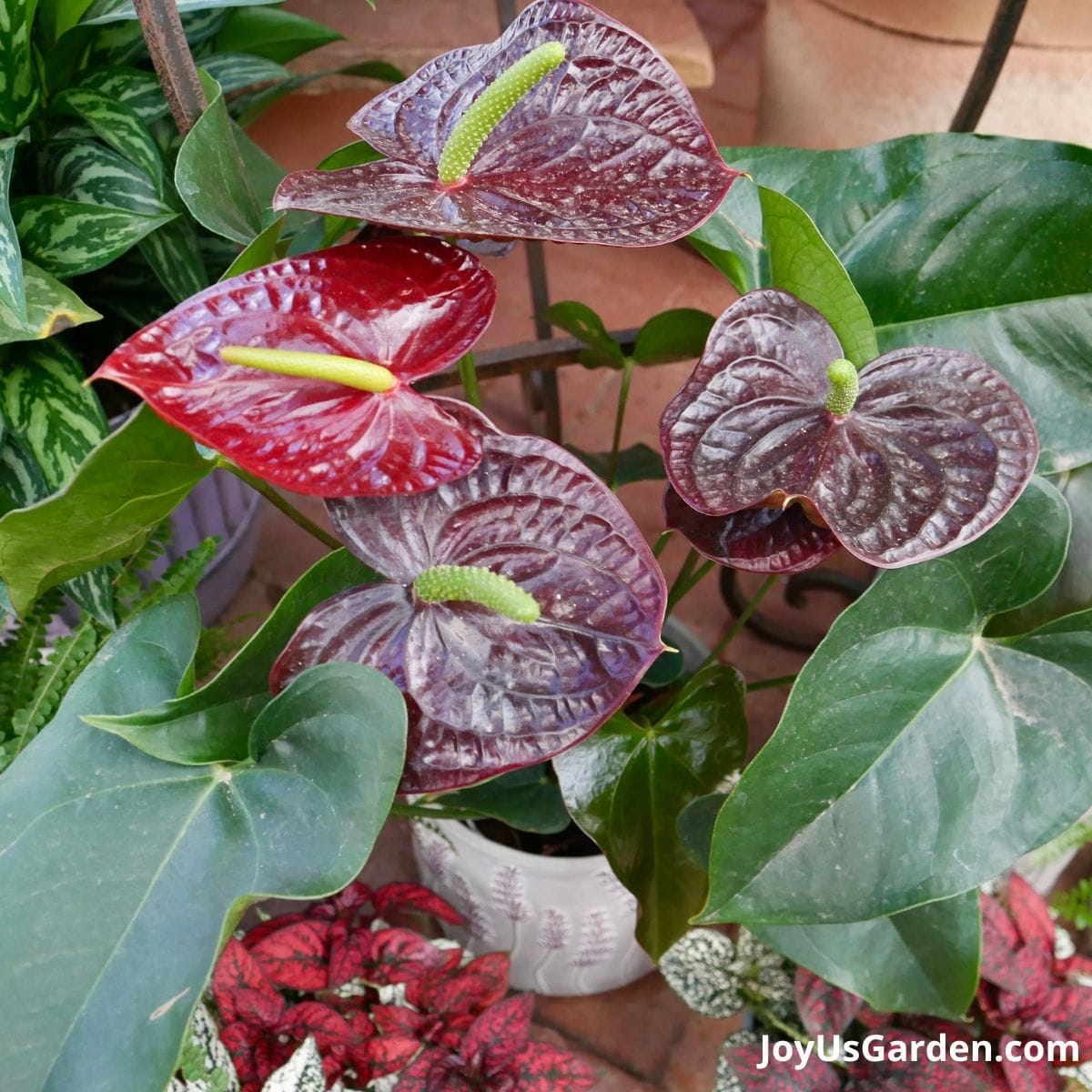
Temperature
If your home is comfortable, it’ll also be so for your houseplants. Anthuriums like warm temperatures in the growing months and cooler in the winter.
Keep them away from any cold drafts and air conditioning or heating vents.
Here are some of our houseplant guides you may find helpful: Guide To Watering Indoor Plants, Beginner’s Guide To Repotting Plants, 3 Ways To Successfully Fertilize Indoor Plants, How to Clean Houseplants, Winter Houseplant Care Guide, How to Increase Humidity for Houseplants.
Humidity
Anthuriums love higher humidity levels! They’re native to the rainforest regions, after all. If the leaves show tiny brown leaf tips, that’s a reaction to the dry air in our homes. Here in hot, dry Tucson, some of the leaves on mine have teeny brown tips, but you must look closely to see them.
I have a large, deep kitchen sink with a faucet water filter. Every time I water my Anthurium, I take it to the sink, spray the foliage and leave it there for an hour or so to temporarily up the ante on the humidity factor. I avoid spraying the flowers, just the foliage.
I have this humidity meter in my dining room. It’s inexpensive but does the trick and still works fine after five years. I run my Canopy humidifiers when the humidity reads low, often in the Arizona desert!
If you think yours look stressed due to low humidity, fill the saucer with pebbles and water. Put the plant on the pebbles but ensure the drain holes and/or the bottom of the pot aren’t submerged in water.
Misting a few times a week should help out too. I like this mister because it’s small, easy to hold, and puts out a nice amount of spray. I’ve had it for over four years, and it’s still going strong.
Do you have a lot of tropical plants? We have a whole guide on Plant Humidity that might interest you.
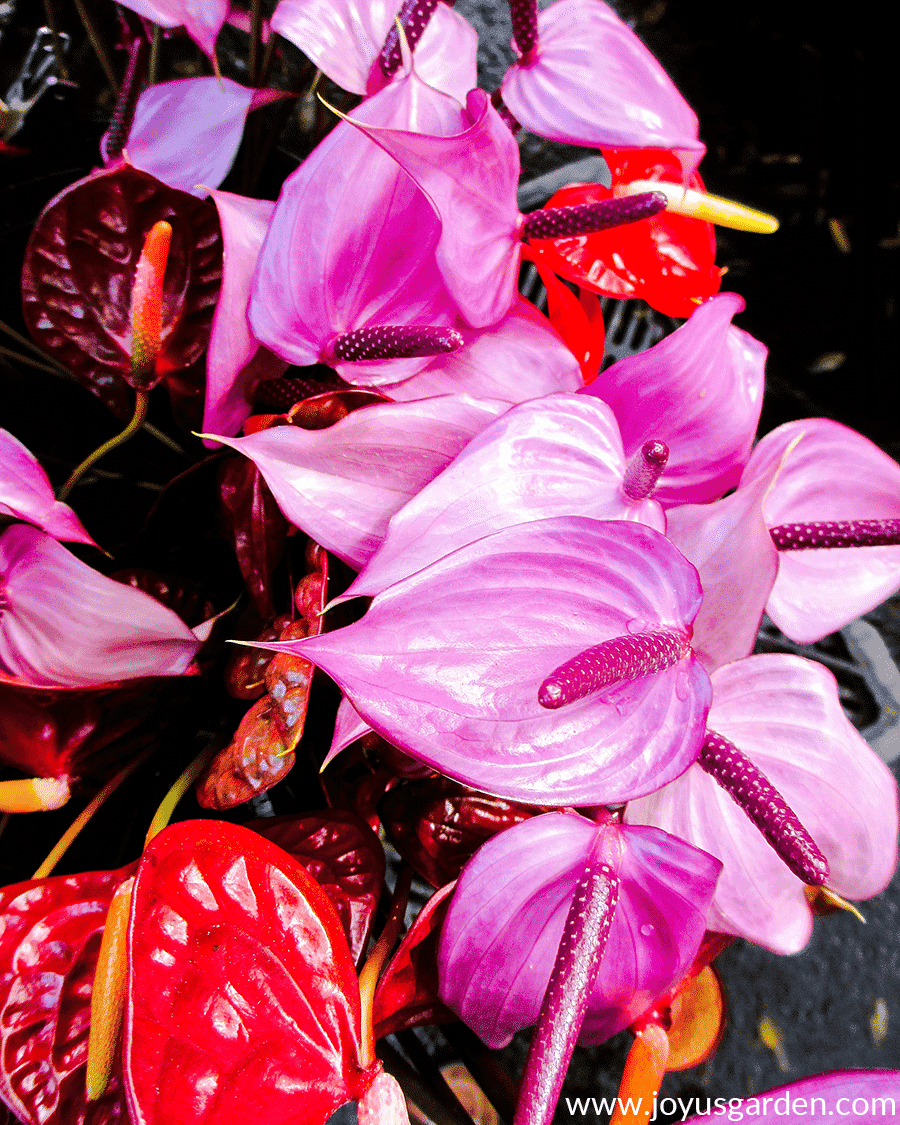
Feeding/Fertilizing Anthuriums
Anthuriums like a phosphorous-rich fertilizer. It’s good for the roots and flowers of a plant and the overall growth and health. The letters on a bottle or box of fertilizer are N-P-K. Phosphorous is the middle number, so having a high ratio for anthuriums is best.
Because anthuriums flower yearly, I feed mine once a month, from March through October. We have a long growing season here. I used Eleanor’s VF-11 in the past, but it’s been out of stock for almost two years.
I now use Sea Grow for my anthurium. The formulation is 16-I6-16. It’s one of the fertilizers I use to feed my 60+ houseplants.
Don’t over-fertilize yours because salts build up and can burn the plant’s roots. This will show up as brown spots on the leaves. Avoid fertilizing a stressed houseplant, i.e., bone dry or soaking wet. You don’t want to fertilize houseplants in the late fall or winter because that’s their time for rest.
I give my houseplants a light application of worm compost with a light layer of compost on top every other spring. I use a 1/4″ to 1/2″ layer of each for a larger-sized houseplant.
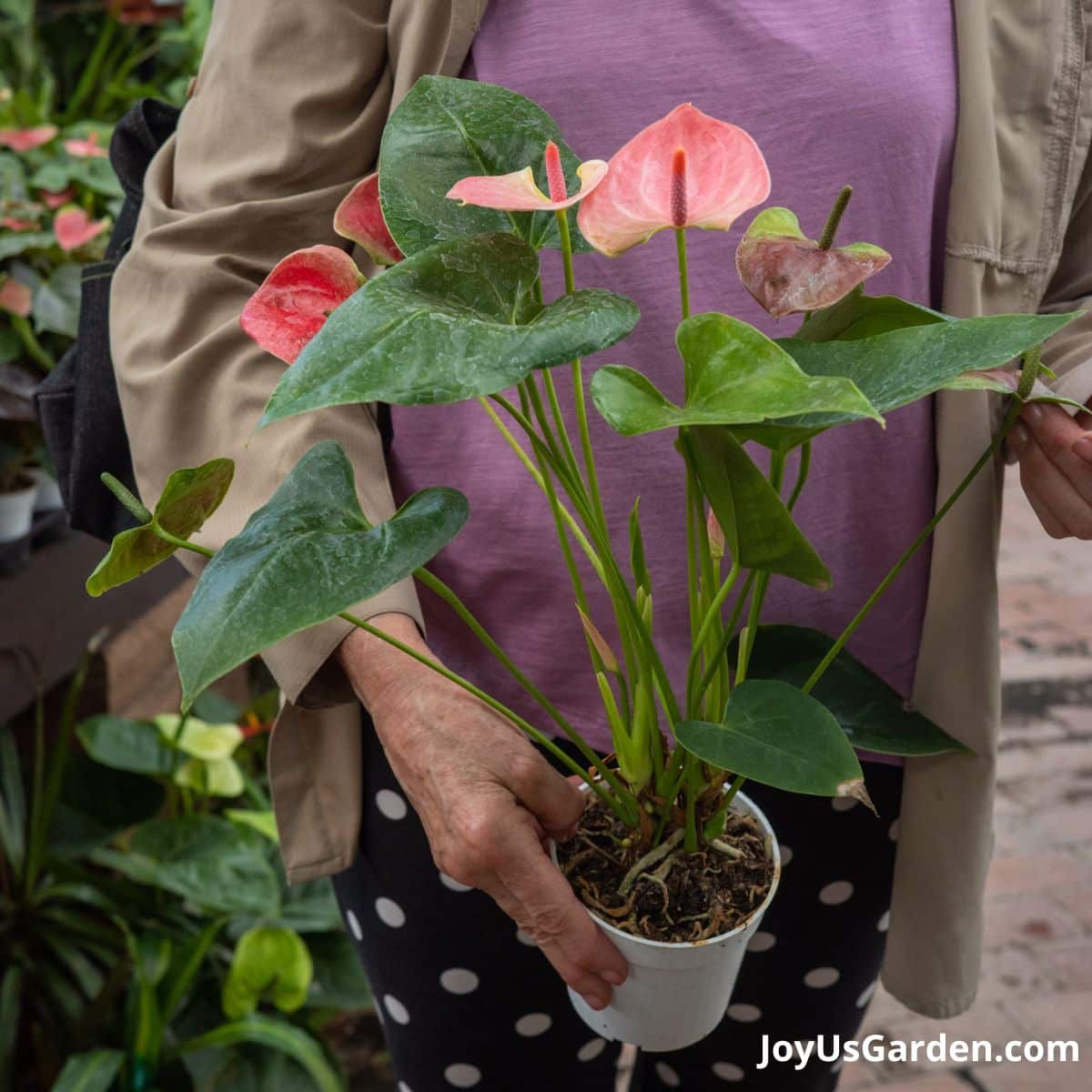
Anthurium Soil
Anthuriums prefer a mix suited for epiphytes. Something coarse, porous, and rich with good drainage. They’re subject to root rot and won’t tolerate sitting in soggy soil.
Mine was growing in sphagnum moss when I bought it. I repotted it into a 1/3 moss, 1/3 coco coir, and 1/3 of my DIY Succulent & Cactus Mix with a handful of compost mixed in.
Alternative mixes include 1) 1/2 peat moss or coco coir and 1/2 orchid bark and 2) cymbidium orchid mix.
Repotting/Transplanting
This is best done in spring or summer; early fall is fine in a warm climate. The faster your plant grows, the sooner it’ll need repotting into a larger pot.
Go up one pot size. If yours is in a 4″ pot, then a 6″ pot is what you want. Make sure there are drain holes on the bottom so the excess water can freely drain out.
Repotting your anthurium every two to five years will be fine.
Anthurium Propagation
An anthurium houseplant is one which I’ve never propagated. It can be done by division, cuttings, and seeds. Some growers use a method called tissue culture.
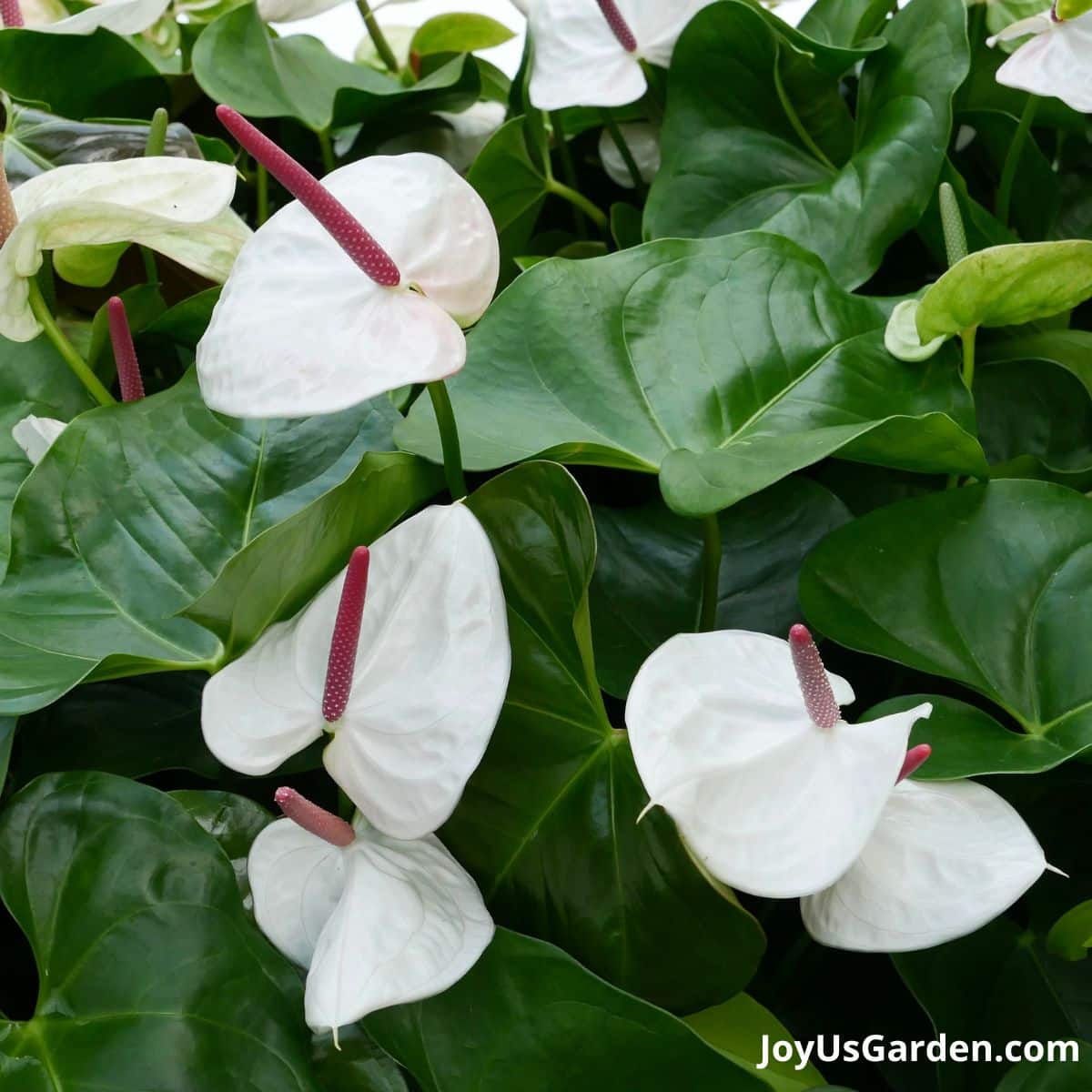
Pruning
Not much is needed. The main reasons to prune your anthurium are to remove the occasional yellow or brown leaf or the spent flowers.
Make sure your pruners are clean and sharp before you do any pruning.
Pests
Mine have never gotten any. They can be susceptible to spider mites and mealybugs, especially deep inside the new growth.
Mealybugs are white, cotton-like pests that hang out in the nodes, on the stems, and under the leaves. I blast them off (lightly!) in the kitchen sink with the spray, which does the trick for a light infestation.
Also, keep your eye out for scale and aphids. It’s best to take action as soon as you see any pest because they multiply like crazy.
Pests can travel from houseplant to houseplant fast, so make you get them under control pronto.
Pet Safety
Anthuriums are considered to be toxic. I consult the ASPCA website for my info on this subject and see in what way the plant is toxic. Here’s more info on this for you.
Most indoor plants are toxic to pets in some way. I share my thoughts on Houseplant Toxicity and our list of 11 Pet-Friendly Houseplants.
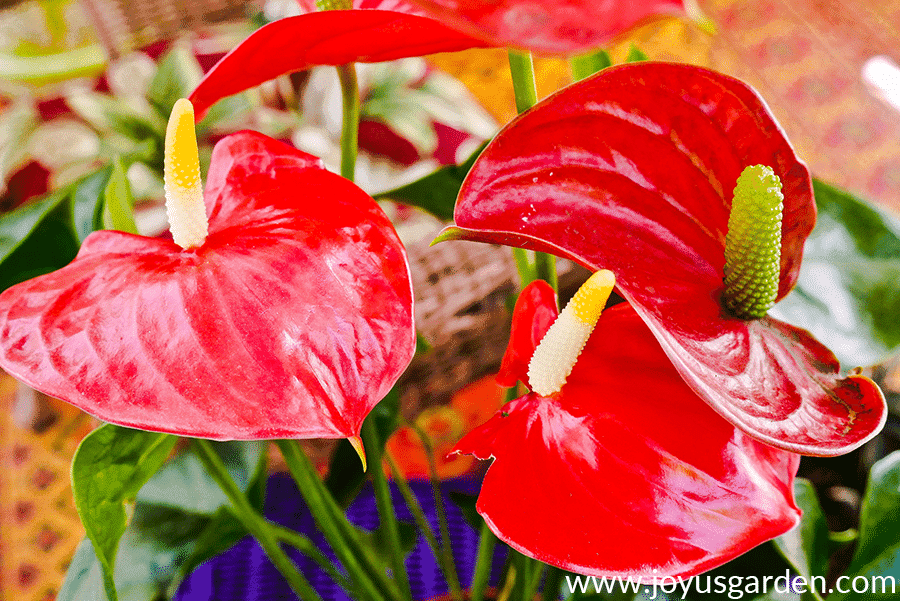
Cleaning the Foliage
Oh yes, plants breathe through their leaves. It’s a good idea to keep them clean. Plus, they’ll look much better!
Both anthurium flowers and foliage are naturally shiny and don’t need any leaf shine product. It blocks their pores and hinders the respiration process.
I cleaned mine before doing this post and video, so it was nice and pretty for you. The best way I’ve found to clean their leaves is with diluted castile soap (which I use for cleaning) onto a wet, soft cloth. I wipe each leaf for the best results. It brings out the natural shine of this plant.
I do the cleaning twice a year or as needed. Any mild, natural liquid soap (like Dr. Bronner’s) is fine.
Anthurium Flowers
Oh yes, we all love those long-lasting flowers! Each lasts 5-7 weeks, depending on how warm and bright your home is. Not all the flowers open at once, so you’ll get a nice long bloom time.
Most anthuriums sold as houseplants have red flowers. Different species and varieties also come in white, purple, pink, and bi-colors like pink/green and red/green.
The red part is the spathe; the flowers are tiny and found on the spadix. Technicalities aside, the whole thing is called the flower.
Mine started to set blooms at the end of winter and is still in bloom in mid-June. It has five open flowers, two of which are freshly open. Because of the low humidity here in the desert, the blooms (and leaves) have gotten smaller each year.
If yours is in low light, it will get fewer, if any, flowers.
When the spadix starts turning green, the flower starts its decline. I always leave them on until they start turning brown and look bad.
Here’s where to deadhead an anthurium flower: go all the way down the stem until you’re at the base of the plant. Cut at that point to remove the whole thing.
Anthurium Care & Growing Guide Video:
4 Reasons Your Anthurium May Not Be Doing Well
- You’re keeping it too wet.
- It’s not getting enough bright light.
- You have it planted in the wrong soil mix.
- There’s not enough humidity.
Speaking again of humidity, Anthuriums prefer it above 50-60%. I used to grow them when I lived in San Francisco. The humidity in that city averages 60-75%. I now live in Tucson, where the average humidity is 20-30%. That’s why I must up the ante on the humidity factor here!
Looking for other blooming houseplants? Check out our guides On Kalanchoe Care, Phalaenopsis Orchid Care, and Calandiva Care.
Anthurium Care FAQs
Water your anthurium when it’s almost completely dry. These plants are epiphytes and don’t like to be kept consistently moist.
No, they do best in bright indirect light. Direct sunlight will burn them.
An occasional brown leaf isn’t a concern. It’s the nature of how plants grow.
If you’re seeing more of them, common causes are too much direct sun, over-fertilizing, a nutrient deficiency, and blight.
Sure, this tropical plant would love it once or twice a week. I mist the foliage and avoid the flowers.
Yes, cut them off, stem and all. The plant will look a lot better.
I always water my anthurium from the top.
Anthuriums aren’t the easiest houseplant, but proper care makes all the difference. The heart-shaped foliage is gorgeous, and the anthurium flower is the big draw. Why not give one a try? Here’s an online source if you can’t find an Anthurium locally.
Note: This was originally published on 6/13/2019. It was updated on 5/5/2023 was new images & more information.
Happy gardening,

This post may contain affiliate links, you can read our policies here.
- About the Author
- Latest Posts
Nell, the founder of Joy Us garden, was born into a gardening family and grew up in Connecticut’s countryside. After living in Boston, New York, San Francisco, & Santa Barbara, she now calls the Arizona desert home. She studied horticulture & garden design, working in the field all her life. Nell is a gardener, designer, blogger, Youtube creator, & author. She’s been gardening for a very long time & wants to share what she’s learned with you.


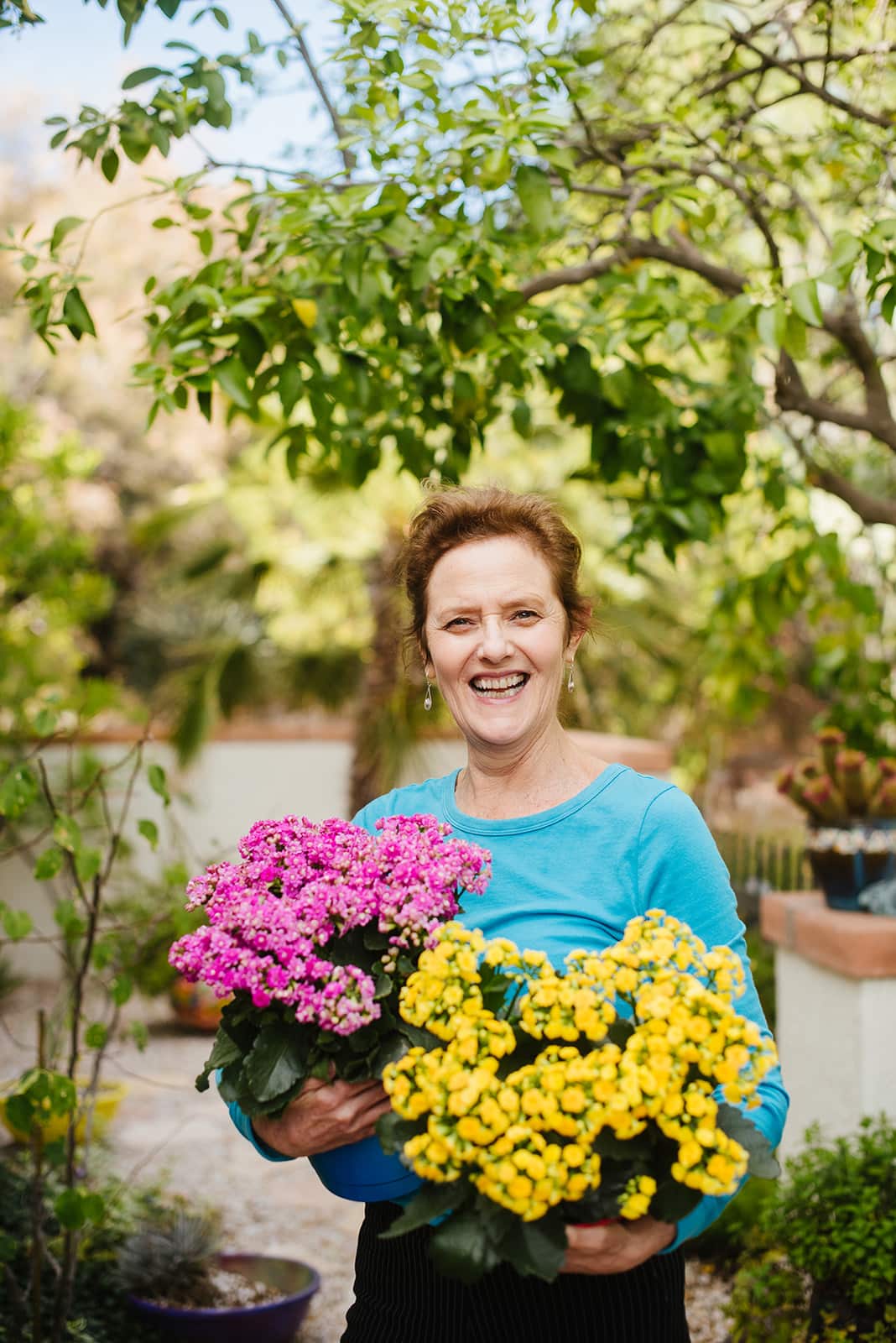
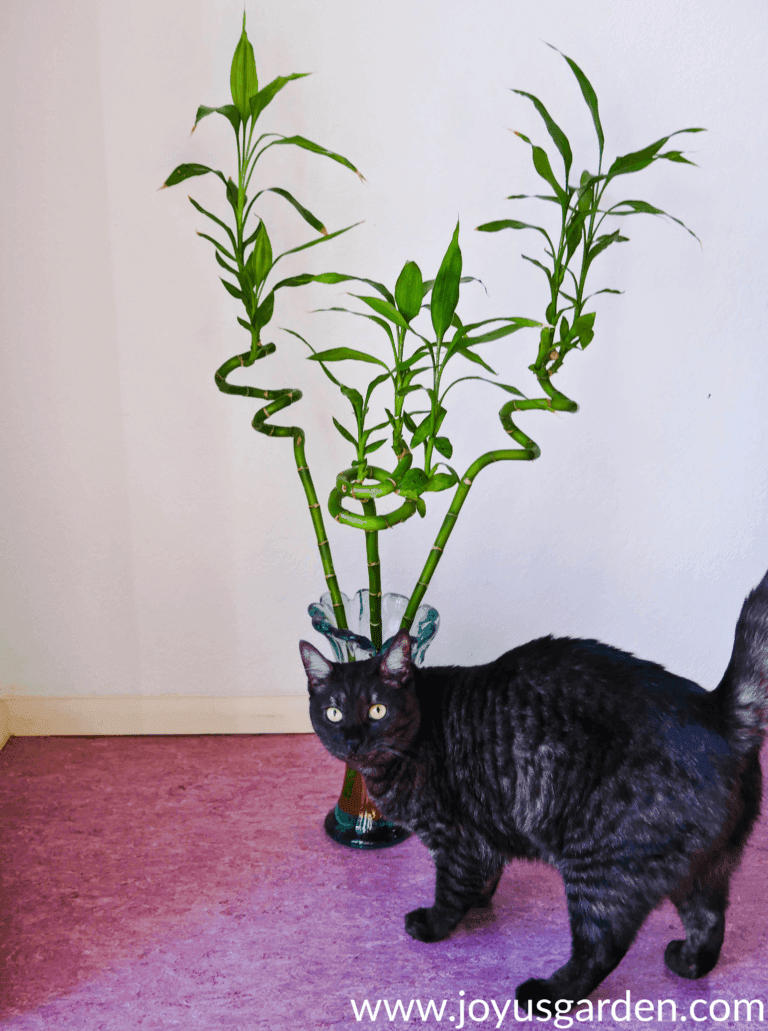

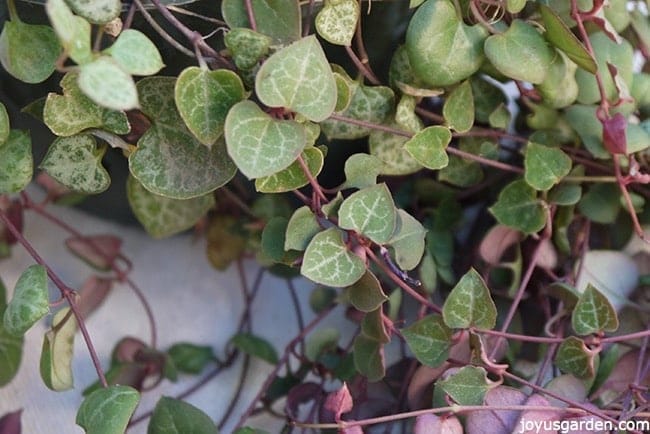
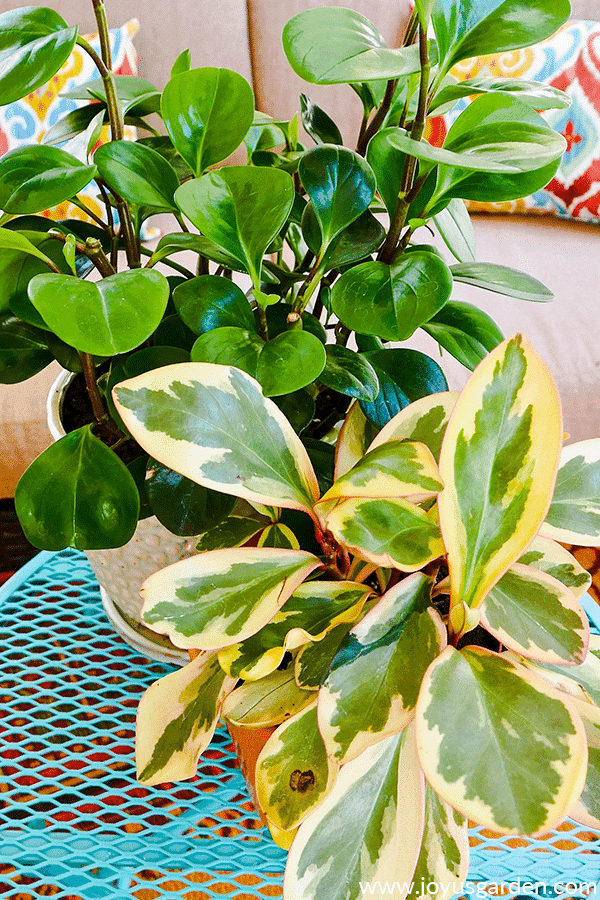

Ronald – Mine still has 1 flower on it after 13 months. The flowering can last a long time! Nell
Thanks for the useful information about Anthurium. I was curious to know, can we add used tea powder to the container. Just to increase little acidity ?
Hi – I’ve never used it. Anthuriums like the soil slightly acidic so I’m not sure if the tea powder would do much for them. Nell
How do you transplant this plant
Hi Maggie – I cover that in the post under Soil & Repotting. I avoid doing it when the plant is in bloom. Nell
I grow mine in mineral water with river stones on the bottom of a glass container . Change water once a week. Keep in a warm but light room.
I got this idea from google.
Hi – I’ve seen that done online too. Nice to know that it works. Thank you for sharing, Nell